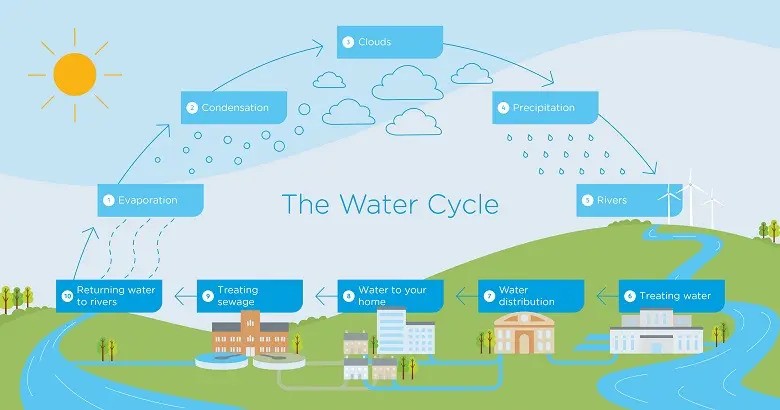The water cycle
On average, we supply more than 2.6 billion litres of our world-class water to each of our 10.1 million drinking water customers every day.
We take this water from rivers and natural underground stores and turn it into high-quality drinking water that we can deliver to your taps at home, work and school.
Once you’ve used the water, we collect it using our sewer network, transport it to our treatment works and recycle it safely back to the environment. This forms part of a larger process called the water cycle.
It's easy to feel as though water is endless, especially after a few rainy days, but that isn't the case. We need to work together to protect our most precious resource for future generations.

1. Evaporation
Water on land and in rivers, lakes and oceans is heated by the sun and evaporates to become water vapour. As it’s lighter than the surrounding air, it floats upwards into the sky – just like steam rising from a kettle.
2. Condensation
As the water vapour rises into the air, it gradually cools and changes back into tiny droplets of water. We call this process condensation, and it’s what causes your bathroom mirror to steam up when you have a bath or hop in the shower.
3. Clouds
When billions of these tiny water droplets come together, clouds are formed.
4. Precipitation
As the droplets in the cloud group together, they become bigger and heavier than the surrounding air. The billions of tiny water droplets then fall to the ground as rain, snow, sleet or hail, depending on the air temperature.
Did you know?
Most people think of us as a rainy country. But our region is actually one of driest in the UK, and London gets less rain than Dallas, Rome and even Sydney! Climate change and a growing population mean that it's more important than ever that we use our water wisely.
5. Rivers
Rainwater flows over the land into lakes, rivers and streams, which take it back to the oceans. It also absorbs into the ground, filling natural underground stores known as aquifers. River water is clean enough to support a variety of wildlife, but it isn’t safe for us to drink until it has been treated.
Did you know?
80% of the water we supply to London and the Thames Valley comes from rivers, while the remaining 20% comes from our aquifers.
6. Treating Water
Once we’ve taken water from rivers and aquifers, we put it through a multi-step treatment process to turn it into top-quality drinking water.
Did you know?
Our team of water samplers and scientists carry out up to half a million tests on our water every year.
Learn about the water treatment process.
7. Water distribution
We pump clean water to your taps via our network of water pipes.
Did you know?
We maintain 20,000 miles of water pipes, some of which are over 150 years old. We’ve replaced over 1,900 miles with new plastic pipes since 2006, helping to reduce leaks by 31%.
8. Water to your home
Baths, showers, washing up, cleaning clothes and flushing the toilet all use large amounts of water. Once water’s been used, we call it wastewater. It’s up to us to collect, transport, treat and safely return wastewater to the environment.
Did you know?
On average, each of our 10.1 million customers uses 143 litres of water a day. This is above the industry average of 142 litres and the Government’s aim of 130 litres.
9. Treating sewage
Wastewater goes down your drain or plughole into our network of sewer pipes. These lead to our sewage treatment works, where we treat the water until it’s clean enough to go back into rivers.
Did you know?
We use over 68,000 miles of sewers, 5,235 pumping stations and 1.48 million manholes to help take the wastewater to our sewage treatment works.
Learn about the sewage treatment process.
10. Returning water to rivers
Water continues its journey, moving from the land to the sky and back again through the cycle of evaporation, condensation, precipitation and collection.
Did you know?
Many parts of the country, including our region, are classed as ‘water stressed’. This means that if we all carry on using the same amount of water, or even more, there may not be enough to go around in the future. We can all do our bit to help by making sure every drop counts.